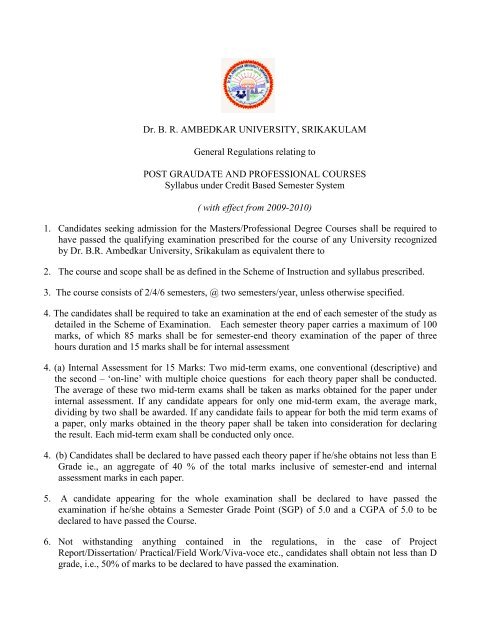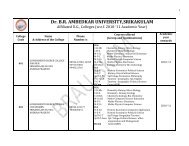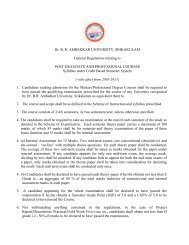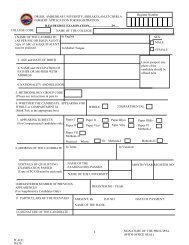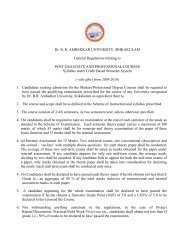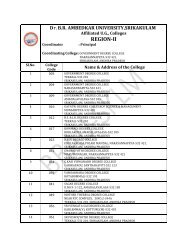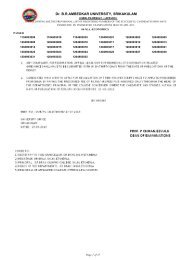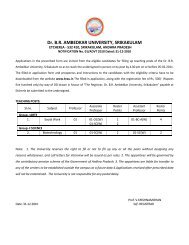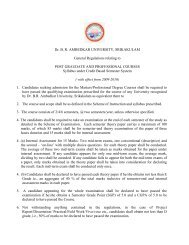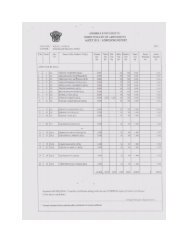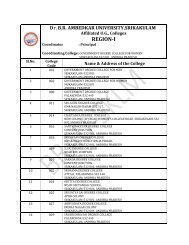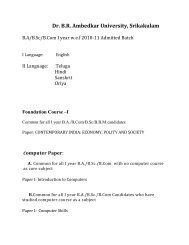M.Sc. Biotechnology - Dr.BR Ambedkar University
M.Sc. Biotechnology - Dr.BR Ambedkar University
M.Sc. Biotechnology - Dr.BR Ambedkar University
Create successful ePaper yourself
Turn your PDF publications into a flip-book with our unique Google optimized e-Paper software.
{6(D)x4(S1)+9(A)x2(S2)+8(B)x4(S3)+7(C)x2(S4)+9(A)x4(S5)+5(E)x4(S6)+9(A)x2(S7)} 162SGPA = ------------------------------------------------------------------------------------------------------------- = ------ = 7.36{4(S1) +2(S2) +4(S3) +2(S4) +4(S5) +4(S6) +2(S7)} 22(9x2+9x4+8x4+8x4+6x2+6x4+9x2+8x4+7x2+9x4+5x4+9x2) 324CGPA = ------------------------------------------------------------------------------ = -------- = 7.71(20+22) 42a) A candidate has to secure a minimum of 5.0 SGPA for a pass in each semester in case of all PG andProfessional Courses. Further, a candidate will be permitted to choose any paper(s) to appear forimprovement in case the candidate fails to secure the minimum prescribed SGPA/CGPA to enable thecandidate to pass at the end of any semester examination.b) There will be no indication of pass/fail in the marks statement against each individual paper.c) A candidate will be declared to have passed if a candidate secures 5.0 CGPA for all PG and ProfessionalCourses.d) The Classification of successful candidates is based on CGPA as follows:i) Distinction –CGPA 8.0 or more;ii) First Class –CGPA 6.5 or more but less than 8.0iii) Second Class –CGPA 5.5 or more but less than 6.5iv) Pass –CGPA 5.0 or more but less than 5.5e) Improving CGPA for betterment of class will be continued as per the rules in vogue.f) CGPA will be calculated from II Semester onwards up to the final semester. CGPA multiplied by “10” givesaggregate percentage of marks obtained by a candidate.
<strong>Dr</strong>. B. R. AMBEDKAR UNIVERSITY, SRIKAKULAMCourseM.<strong>Sc</strong> <strong>Biotechnology</strong>ANNEXURE – IEligibilityQualifying Examination for AdmissionB.<strong>Sc</strong>/B.<strong>Sc</strong>(Vocational with any two ofthe following subjects: <strong>Biotechnology</strong>,Biochemistry, Botany, Zoology,Chemistry Microbiology, Env. <strong>Sc</strong>ience,Human Genetics,Fisheries, Aquacultureand Mathematics, B.<strong>Sc</strong> (Vocational)with food <strong>Sc</strong>ience & Quality Control
ANNEXURE – IIM.<strong>Sc</strong>. BIOTECHNOLOGYSCHEME OF INSTRUCTIONFirst Semester:____________________________________________________________________________________Course Title of the Paper Compulsory/Elective No.of Periods ofNo.instruction per Week____________________________________________________________________________________101 Cell Biology Compulsory 4102 Biomolecules Compulsory 4103 Microbial Physiology & Genetics Compulsory 4104 Analytical Tools and Techniques in <strong>Biotechnology</strong> Compulsory 4105 Lab-I: Cell Biology and Microbiology Compulsory 12106 Lab-II: Biochemical Analysis and Techniques Compulsory 12____________________________________________________________________________________Second Semester:____________________________________________________________________________________Course Title of the Paper Compulsory/Elective No.of Periods ofNo.instruction per Week____________________________________________________________________________________201 Enzymology and Metabolism Compulsory 4202 Molecular Biology Compulsory 4203 Genetic Engineering Compulsory 4204 Biology of Immune System Compulsory 4205 Lab-III: Molecular Biology & Genetic Engineering Compulsory 12206 Lab-IV: Enzymology and Immunology Compulsory 12____________________________________________________________________________________
Third Semester:____________________________________________________________________________________Course Title of the Paper Compulsory/Elective No.of Periods ofNo.instruction per Week301 Cell Culture Technology and Tissue Engineering Compulsory 4302 Plant <strong>Biotechnology</strong> Compulsory 4303 Animal <strong>Biotechnology</strong> Compulsory 4304 Medical and Environmental <strong>Biotechnology</strong> Compulsory 4305 Lab-V: Plant Tissue Culture Techniques Compulsory 12306 Lab-VI: Animal Cell Culture and Environmental Compulsory 12<strong>Biotechnology</strong>___________________________________________________________________________Fourth Semester:____________________________________________________________________________________Course Title of the Paper Compulsory/Elective No.of Periods ofNo.instruction Per Week____________________________________________________________________________________401 Heterologous Expression and Downstream Processing Compulsory 3402 Bioinformatics and Biostatistics Compulsory 3403 Lab-IV: Industrial <strong>Biotechnology</strong> and Bioinformatics Compulsory 6404 Project work* Compulsory405 Seminar@ Compulsory406 Comprehensive Viva-voce Compulsory____________________________________________________________________________________
In each of the semesters each candidate has to present a paper on <strong>Biotechnology</strong> and related topics,according to the schedule given by the Department for 20 Minutes on Saturday in the SEMINAR conductedby the Department.*Project Work: Candidates shall have to do a project work in the field of <strong>Biotechnology</strong> and related fields in reputedOrganizations/ Companies/ Lboratories etc.. for a period of two months at the end of IV Semester. The candidate shallsubmit the project work dissertation under the supervision of a faculty member.@Seminar: Each student shalll give seminar on project work dissertation.During all the four semesters the medium of instruction and writing examination is ENGLISH only.
Annexure - III<strong>Sc</strong>heme of Examination as per Credit SystemFirst Semester:Course No.Title of the PaperCredit PointsMax.Marks.Double Valuation (Internal +External)Internal Assessment101 Cell Biology 4 100 8 85 1 15102 Bio Molecules 4 100 8 85 1 15103 Microbial Physiology & Genetics 4 100 8 85 1 15104 Analytical tools & Techniques in Bio Technology 4 100 8 85 1 15105 Lab I : Cell Biology & Microbiology 2 50 4 45 5106 Lab I I : Bio Chemical Analysis & Techniques 2 50 4 45 5Total 20 500 430 7 70
Second Semester:Course No.Title of the PaperCredit PointsMax.Marks.Double Valuation (Internal +External)Internal Assessment201 Enzymology & Metabolism 4 100 8 85 1 15202 Molecular Biology 4 100 8 85 1 15203 Genetic Engineering 4 100 8 85 1 15204 Biology & Immune System 4 100 8 85 1 15205 Lab I : Molecular Biology & Genetic Engineering 2 50 4 45 5 5206 Lab II : Enzymology & Immunology 2 50 4 45 5 5Total 20 500 430 70
Third Semester:CourseNo.Title of the PaperCredit PointsMax.Marks.Double Valuation(Internal + External)Internal Assessment301 Cell Culture Technology & Tissue Engineering 4 100 85 15302 Plant Bio Technology 4 100 85 15303 Animal <strong>Biotechnology</strong> 4 100 85 15304 Medical & Environmental Bio Technology 4 100 85 15305 Lab I : Plant Tissue Culture Techniques 2 50 45 5306 Lab II : Animal Cell Culture & Environmental BioTechnology2 50 45 5 5Total 20 500 430 7 70
Fourth Semester:CourseNo.Title of the PaperCredit PointsMax.Marks.401 Heterologous Expression & Down Stream Processing 4 100 8 85 15402 Bio Informatics & Bio Statistics 4 100 8 85 15403 Lab: Industrial BioTechnology & Bioinformatics 2 50 45 05404 Project Work & Dissertation 6 150 150 -405 Seminar 2 50 4 50 -406 Comprehensive Viva - voce 2 50 4 50* -Double Valuation (Internal + External)Internal AssessmentTotal 20 500 465 35* Single Valuation by Viva-Voce committeeTotal Marks :- First, Second, Third & Fourth Semesters put together: 500+500+500+500 = 2000Total Credits :- First, Second, Third & Fourth Semesters put together: 20+20+20+20 = 80
<strong>Dr</strong>. B.R. <strong>Ambedkar</strong> <strong>University</strong>, SrikakulamM.<strong>Sc</strong> BIOTECHNOLOGYI SEMESTERObjectives101: CELL BIOLOGYTo understand the molecular events & regulations of cell cycleTo know the stricter of plasma membraneTo know the morphology & functions of Endoplasmic reticulumTo understand the mechanism of photo photophosphorylation & oxidative phosphorylation.To understand the process of evaluationUNIT-IStructure of typical bacterial, plant and animal cells and functions of cell organelles. Mechanismof cell division. Cell cycle – Molecular events including cell cycle check points and Cdk – cyclincomplexes and their role in cell cycle regulation.UNIT-IIUltra structure of plasmamembrane - Components and membrane asymmetry. Transportprocesses - active transport, ionophores and ion channels. Exo and endocytosis. Phago andpinocytosis.UNIT-IIIGeneral morphology and functions of endoplasmic reticulum. Signal hypothesis. Ribosomes -eucaryotic and procaryotic. Ribosomal proteins. Role of Golgi in protein secretion. Lysosomesand peroxisomes. Cytoskelatal elements. Cell – cell interaction.UNIT-IVMitochondria - structure, biogenesis and enzymatic compartmentation. Organization ofmitochondrial respiratory chain, mechanism of oxidative of phosphorylation. Ultra structure ofthe chloroplast. Photosynthesis - photophosphorylation. Carbon dioxide fixation in C-3, C-4 andCAM plants. Photorespiration.UNIT-VOrganic evolution: Origin of life. Species concept, population, dones, races, and subspecies.Mechanisms of speciation. Role of isolating mechanisms. Lamarckism, Darwinism, Neo-Darwinism, synthetic theory of evolution. Micro, macro and mega evolution, sequential anddivergent evolution. Natural selection.
BOOKS RECOMMENDED:1. Molecular Biology of the Cell by B.Alberts et.al (Garland publications incorporation.)2. Molecular Cell Biology, J. Darnell et. al (<strong>Sc</strong>ientific American Books) .3. Cell Biology by N.O.Thorpe (John wiley & sons).4. Organic Evolution by Rastogi.5. Principles of organic evolution by J.L.Stebbins (Prentice Hall).
I SEMESTER102: BIOMOLECULESObjectives To learn the chemical foundation of Biology To learn the classification ,stricter sproperties of carbohydrates & lipids To learn the classification & stricter of Amino acids To learn the stricter & properties of nucleosids & vitamins To study the classification & mechanism of hormones.UNIT-IChemical foundations of Biology – Molucular Stuctre and process in terms of Space, time andenergy. Covalent and non covalent (Weak) Bonds, important properties of water . pH, pK, acids,bases, buffers.UNIT-IIClassification, structure, properties and biological significance of carbohydrates.Monosaccharides, Disaccharides, and Polysaccharides. Biological role of peptidoglycans,glycosamino glycans and Lectins. Lipids - classification, structure and properties of fatty acids,triglycerides, phospholipids, sphingolipids and cholesterol.UNIT-IIIAmino acids - Classification, structure and physico-chemical properties. Chemical synthesis ofpeptides – solid phase peptide synthesis. Proteins - classification, purification and criteria ofhomogeneity. Structural organization, sequence determination and characterization of proteins.Conformation of proteins – Ramachandran plots. Denaturation of proteins. Hetero cycliccompounds – Heme and Chlorophylls.UNIT-IVStructure and properties of purines, pyrimidines, nucleosides, and nucleotides. Covalentstructure of DNA and different forms of DNA - A,B and Z. DNA super coiling. Types of RNA andcovalent structure of t-RNA. Classification, structure and physiological roles of Vitamins.UNIT-VHormones- classification and mechanism of action of steroid and protein hormones. Signaltransduction cascade by cyclic AMP, Phospho inositate and calcium (Ca + ), G-proteins, growthfactors and membrane receptor tyrosine kinases. Phytohormones and their physiological roles.
BOOKS RECOMMENDED:1. Principles of Biochemistry by A.L.Lehninger, 2 Ed. (worth).2. Biochemistry by L. Stryer 4 Ed. (Freeman-Toppan).3. Text Book of Biochemistry by West et. al., (Mac Millan).4. Principles of Biochemistry by Smith et. al., (Mc Graw Hill).5. Harper’s Biochemistry (Langeman).6. Biochemistry by D.Voet and J.G.Voet (John weily).7. Biochemistry by U.Satyanarayana (Books & alied (p) Ltd
I SEMESTER103: MICROBIAL PHYSIOLOGY & GENETICSObjectives To study the process of sterilization To study the classification & culture methods of bacteria To understand the economic importance of micro organization. To study the genetics in prokaryotic gene. To study the genetics in Eukaryotes.UNIT-IMethods of sterilization, pasteurization and disinfection. Microbes as pathological agents in plantand animals. Biohazards - safety precautions.UNIT-IIClassification and cultivation of bacteria. Bacterial reproduction and growth curve. Preparationof bacteriological media. Staining techniques. Differences between gram positive and gramnegative bacteria. Micro biology of water, milk, air, soil and sewage.Clinically importantbacteria.UNIT-IIIChemical nature and classification of bacteriophages. Parasitic and temperate phages. Plantand animal viruses – multiplication of viruses. General characteristics of T Phage, φx174, SV40,TMV. Clinically important viruses, retroviruses, HIV, Hepatitis B Virus and viral infections.General account of algae, molds and yeasts. Economic importance of algae and fungi. Clinicallysignificant protozoans.UNIT – IVMicrobial genetics: Recombination in prokaryotes, Transformation, conjugation, transductionand sexduction. Mapping of prokaryotic gene. Transposons, retrotransposons and mechanismof transposition. Viral genetics. Biology of plasmids. Extra chromosomal inheritance.UNIT-VGenetics of Eukaryotes: Gene & Environment, Genotype and phenotype, Mendel’s experiments,Dominance relationships. Multiple alleles, Gene Interaction, Gene mutations, Sexdetermination, Sex linkage, Linkage and recombination in diploids. Tetrad analysis. Elements ofgene mapping, Pedigree analysis.
BOOKS RECOMMENDED:1. Text book of Microbiology by Pelczar and Reid (Mc Graw Hill).2. Microbiology by Tortora, Funk & Case.3. Microbiology by Prescott.4. Principles of Genetics by Sinnet et.al,., (Mc Graw Hill).5. Principles of Heridity by Robert Tumarin.6. Genetics by M.W.Strick Berger (Mac Millan).7. Cell and Molecular Biology by E,D.P.De Roberties (International edition).
I SEMESTERObjectives104: ANALYTICAL TOOLS AND TECHNIQUES IN BIOTECHNOLOGYUNIT-I To learn the principle & applications of various microscopes. To understand the properties & nature of electromagnetic radiation. To learn the separation techniques by means of chromatography To learn the principles of electrophoresis To understand use of radio isotopes in biology To learn the detection & measurements of radio activity.Principles and applications of light, phase contrast, fluorescence, scanning and transmissionelectron microscopi. Flow cytometry.UNIT-IIProperties of electromagnetic radiations. Principles, instrumentation and applications of UV,visible, infrared, ORD, CD, NMR spectroscopy. Spectrofluorimetry and mass spectrometry, X-ray diffraction.UNIT-IIIPrinciples and applications of gel-filtration, ion-exchange and affinity chromatography. TLC, GLCand HPLC. Basic principles of sedimentation. Applications of preparative and analytical ultracentrifuges. Principles and applications of lyophilization.UNIT-IVGeneral principles of electrophoretic techniques. Poly Acryl amide Gel Electrophoresis. Isoelectricfocusing. Isotachophoresis. 2-D Electrophoresis. Capillary electrophoresis. Agarose gelelectrophoresis of DNA and RNA. Blotting techniques. DNA fingerprinting.UNIT-VStable and radioactive isotopes. Detection and measurement of radioactivity. Applications ofradioisotopes in biological sciences. Autoradiography. Non-isotopic tracer techniques. Principlesand range of electrochemical techniques. Operation of pH electrodes. Principles and applicationsof Ion-selective and gas sensing electrodes. Oxygen electrodes.
BOOKS RECOMMENDED1. Analytical Biochemistry by David J.Holme (Long man).2. A Biologists guide to Principles and techniques of practical Biochemistry. Ed.by.B.D.williams(Edward Arnold).3. Instrumental methods of chemical analysis by G.K.Sharma (Goel).4. Modern experimental Biochemistry by Rodney Boyer (Pearson Education)5. Physical Biochemistry by Frefielder (Freeman & Co).6. Biophysical chemistry principles and techniques by Upadyay, Upadyay and Nath ( Himalayapublishing).7. Instrumental methods of chemical analysis by Chatwal & Anand.
I SEMESTER105: LAB - I: CELL BIOLOGY AND MICROBIOLOGY01. Mitosis in onion root tip cells: All phases (Squash method).02. Meiosis in onion flower buds: All phases including zygotene, diplotene and diakinesis ofprophase I (Smear method).03. Preparation of liquid and solid media for growth of microorganisms.04.Slants and Stab cultures, Isolation and maintenance of microorganisms by plating, streakingand serial dilution methods.05. Biochemical characterization of selected microbes.06. Simple staining and Grams staining.07. Acid fast and spore staining.08. Microscopic examination of bacteria, yeast and molds.09. Growth of a microorganism and growth curve.10. Analysis of water for portability and determination of MPN.11. Microbiological examination of milk.12. Oligodynamic action of heavy metals.13. Evaluation of disinfectants by phenol coefficient method.14. Isolation of viruses.15. Examination of thallus structure and reproductive bodies of algae.16. Examination of external features and reproductive organs of fungi.17. Representative species of protozoa.BOOKS RECOMMENDED:1. Handbook of Microbiological Media by Atlas R.L.2. Manual of Clinical Microbiology by Lennettee E.H.3. Manual of Clinical Microbiology by Murray PR.4. A Laboratory manual of Microbiology: Microbes in Action.
I SEMESTER106: LAB-II: BIOCHEMICAL ANALYSIS AND TECHNIQUES01. Separation of amino acids by paper chromatography.02. Separation of amino acids/ sugars/ lipids by Thin Layer Chromatography.03. Ultra violet absorption spectra of nucleic acids and proteins.04. Determination of molar extinction coefficient of tryptophane / tyrosine.05. Gel filtration of proteins.06. Ion exchange chromatography of amino acids.07. Purification of enzyme by affinity chromatography.08. Subcellular fractionation by differential centrifugation.09. Polyacrylamide gel electrophoresis of proteins.10. Determination of isoelectric point of glycine.11. Estimation of glycine by formal titration.12. Estimation of reducing sugars by Benedict’s titrimetric method.13. Estimation of total carbohydrates by anthrone method.14. Estimation of proteins by Lowry and Bradford methods.15. Estimation of ascorbic acid.16. Determination of Iodine value of oils.17. Estimation of cholesterol.
BOOKS RECOMMENDED:01. Hawk's physiological chemistry Ed. by Oser (Mc Graw Hill).02. Biochemical methods By Sadasivam and Manikam (Wiley Eastern limited).03. An introduction to practical biochemistry by D.T.Plummer (Mc Graw Hill).04. Laboratory manual in Biochemistry by J.Jayaraman (Wilety Eastern limited).05. Biochemistry - a laboratory courses by J.M.Beckar (Academic Press).
M.<strong>Sc</strong>., (Previous) BIOTECHNOLOGYII SEMESTERObjectives201: ENZYMOLOGY & METABOLISM To understand the classification & nomenclature of enzymes. To understand the factors effecting on enzymatic reaction. Understand the mechanism of Enzyme action Study the effects by the inborn errors of the metabolism Understand the synthesis & degradation process of amino acids & nucleic acids.UNIT – IClassification and Nomenclature of Enzymes. Assay of Enzyme Activity- units of enzymeactivity. Coenzymes, metalloenzymes, and isoenzymes with examples. Ribozymes and catalyticantibodies.UNIT-IIEnzymekinetics: Factors affecting the rates of enzyme catalysed reactions. Enzyme – substrate(protein ligand) binding. Michaelis- Menten equation.Methods of Measurement of k m . Enzymeinhibition – Competitive, non-competitive and uncompetitive. Allosteric enzymes and theirproperties with examples-Multisubstrate reactions.UNIT – IIIZymogen activation- Covalent modification- Active site determination. Mechanism of enzymeaction of chymotrypsin,Trypsin ( serine proteases), carboxy peptidase-A and ribonuclease A.Multienzyme systems.UNIT – IVGlycolysis, Glycogenolysis, glycogenesis, gluconeogenesis, HMP shunt path way and theirregulation. Tricarboxylic acid (TCA) cycle, Glyoxylate cycle and its significance. Biosynthesis andoxidation of fatty acids- The concept of free energy- Energy rich compounds. Metabolism ofcholesterol. Ketone bodies. Biosynthesis of Heme and chlorophylls.UNIT – VProtein turnover. General metabolic reactions of amino acids. Urea cycle. Nitrogen fixation.Essential and non-essential amino acids. Biosynthesis and degradation of aromatic andbranched chain aminoacids. Inborn errors of amino acid metabolism. Biosynthesis of purine andpyrimidine nucleotides and their regulation. Catabolism of purines and pyrimidines.
BOOKS RECOMMENDED:1.Principles of Biochemistry by A.L.Lehninger, 2 Ed. (worth).2.Lehninger Principles of Biochemistry by Nelson, D and Cox, D. Macmillon Pub.3.Biochemistry by L.Stryer 5 Ed. (Freeman-Toppan).4.Text Book of Biochemistry by West et. al., (Mac Millan).5.Principles of Biochemistry by Smith et. al., (Mc Graw Hill).6.Harper’s Biochemistry (Langeman).7.Biochemistry by D.Voet and J.G.Voet (John wiley).8.Enzoyms by Trevor PalmerThe Horwood publishing colophon Chichester, UK
202: MOLECULAR BIOLOGYObjectives To study the genetic material organization To understand the process of DNA Replication To understand the process of DNA transcription To understand the process of DNA gene regulation To understand the process of DNA protein targeting.UNIT – IOrganization of genetic material - Packing of DNA into chromatin - protein components ofchromatin, histones, nucleosome organization. Solenoids loops, domains & scaffolds. polytenechromosomes. Fine structure of the eukaryotic gene. Split genes. Different kinds of genes:overlapping, assembled, polyprotein & nested genes.UNIT – IIDNA replication – apparatus, enzymes involved and mechanism. Replication at telomeres.DNA damage and repair mechanism. Nuclear genome.C - value paradox. Mitochondrial &plastid genomes and genes.UNIT – IIITranscription in prokaryotes and eukaryotes.Mechanism of transcription, enzymes andtranscription factors, zinc finger, leucine zipper mechanism. Maturation and processing of m-RNA, splicing, 5' end capping & 3' end tailing. RNA editing and transport. RNAi and smallRNA’sUNIT – IVTranslation in prokaryotes and eukaryotes: Genetic code - properties of the genetic code,deciphering of the genetic code. Ribosome as a translation factory. t - RNA as an adaptor, itsmode of function. Post translational modifications. Leader sequences & protein targeting.UNIT – VRegulation of gene expression in prokaryotes - The operon concept, lac & trip operons.Transcriptional control. Post translational control. Regulation in eukaryotes - Control bypromoter, enhancer and silencers. Cis-trans elements. Environmental & developmentalregulation. DNA methylation & gene expression. Chromatin structure & gene expression.
BOOKS RECOMMENDED:1. Biochemistry by L.Stryer 5 Ed. (Freeman-Toppan)2. Genes VIII by B.Lewin (Oxford)3. Cell and Molecular Biology by E,D.P.De Roberties (International edition)4. Molecular Biology by David Frefielder.5. DNA <strong>Sc</strong>ience by Carolina Publishing Company.6. Molecular Biology of the Gene by J.D.Watson et. al.,(Benjamin).7.RNAi – Design and application by Barik (Springer) 20088.Small RNA’s – Analysis and regulatory functions by Nellen (Springer) 2008.
203: GENETIC ENGINEERINGObjectives To learn the isolation procedure of nucleic acids To understand the process of cloning To learn the character& importance & cloning vectors To learn the gene transfer techniques To learn the process of PCR & its application.UNIT-IIsolation of DNA and RNA from natural sourses. DNA sequencing by chemical and enzymaticmethods. Restriction mapping- Nucleic acid blotting – Southern and northern blotting.UNIT-IIDNA cloning. Enzymes used in genetic engineering : Restriction endonucleases - types,nomenclature and properties. DNA polymerase-I, polynucleotide kinase, DNA ligase, terminalnucleotide transferase, Reverse transcriptase, alkaline phosphatase, S 1 nuclease.UNIT-IIISalient features of cloning vectors, types of cloning vectors - plasmids, cosmids, phages(lambda and M13 phages), animal (SV40, Baculo) and plant (CMV) viruses, Artificialchromosomes - YACs and MACs. Ligation of foreign DNA to vectors - cohesive and blunt endmethods - homopolymer tailing and adaptors. Preparation of gene libraries and c-DNA libraries .UNIT – IVTechniques of gene transfer - transformation , transfection, micro injection, electroporation,lipofection and biolistics. Selection of r-DNA clones and their expression. Nucleic acid probes,colony and fluorescent in-situ hybridization.UNIT – VPolymerase Chain Reaction and its applications. DNA micro array technology. Applications ofgenetic engineering in agriculture, animal husbandry, medicine and in industry. Genomics –genome sequencing by shot gun and hierarchical method. Genome annotation – identificationof genes, promoters and exon – intron boundries.
BOOKS RECOMMENDED:1. Recombinant DNA technology by Watson et. al., (<strong>Sc</strong>ientific American Books).2. Genes-VIII by Benjamin Lewin.(Oxford).3. Principles of Gene Manipulation by Old and Primrose.(Blackwell).4. DNA <strong>Sc</strong>ience by Carolina Publishing Company.5. From genes to clones by Winneker.6. From genes to genomes concepts and applications of DNA technology by Jeremy W daleand Malcolm von <strong>Sc</strong>rantz, Weil publications7. Molecular <strong>Biotechnology</strong> by Glick.8. Genetic Engineering by Sandhya Mitra.9. Genomes by T.A. Brown
204: BIOLOGY OF THE IMMUNE SYSTEMObjectives To learn the types of immunity & organs involved in immune system To learn about the cells involved in immune system To understand the process of MHC To understand the diagnostic process of diseases by immunological techniques To learn the production of chimeric and monoclonal Ab To know about the hypersensitivity To learn the process of vaccination and development of vaccineUNIT-ITypes of immunity – innate, acquired, passive and active. Organisation and structure oflymphoid organs – bone marrow, thymus, spleen and lymphnodes.UNIT-IICells of the immune system – B-Lymphocytes, T-Lymphocytes. T-cell receptor – structureand function. Macrophages. Types of cell mediated immunity and lymphokine activated killercells. Clonal nature of immune response, Immunological memory. Immuno regulation.Adjuvants and immunological tolerance.UNIT-IIINature of antigens and antibodies. Structure and function of antibodies. Isotypes, Allotypes andIdiotypes. Antigen – antibody interactions. The generation of antibody diversity, antigenreceptors on B & T lymphocytes. Major Histocompatibility Complex (MHC). Human leucocyteantigens (HLA), MHC restriction and typing. Lymphokines, effector cell mechanisms, geneticcontrol of immune response. Complement system.UNIT-IVImmunological techniques - ELISA, RIA, Western Blot, Immunoblot and Immuno fluorescenttechniques. FACS. Hybridoma technology - production and applications of monoclonalantibodies. Antibody engineering, chimeric antibodies.UNIT-VHypersensitivity - types of hypersensitivity - immediate and delayed hypersensitivity,autoimmune diseases, transplantation and immunity, immunity to infectious agents. Vaccinesand Vaccination, types of vaccines including new generation vaccines. Tumor immunology.
BOOKS RECOMMENDED:1. Essentials of Immunology by Roit (ELBS).2. Immunology by Roit et.al (Harper Row).3. Text book of Immunology by S.T,Barrot (Mosby).4. Immunology by Kuby.5. Principles of Microbiology and Immunology by Davis et.al., (Harper).
205 LAB III: MOLECULAR BIOLOGY AND GENETIC ENGINEERING01. Isolation of RNA from yeast.02. Estimation of RNA using orcinol reagent and by UV spectrophotometry.03. Isolation of DNA from microbial, plant and animal sources.04. Estimation of DNA using diphenylamine reagent and by UV spectrophotometry.05. Enzyme induction in E.Coli.06. Isolation of plasmid DNA.07. Digestion of plasmid DNA with restriction endonucleases.08. Separation of DNA fragments by Agarose gel electrophoresis.09. Elution of DNA from agarose gels.10. Ligation of DNA fragments.11. Bacterial transformation and identification of transformants.12. Cloning of green fluorescent protein.13. Gene expression in bacteria.14. Amplification of DNA by PCR.15. Southern blotting technique.16. RFLP and RAPD mapping.BOOKS RECOMMENDED:01. <strong>Biotechnology</strong>: A laboratory course by Becker J.M.02. Molecular Cloning : A laboratory manual Vols. 1-3, Sambrook, J.03. Lab manual in Biochemistry by J.Jayaraman (Wiley Eastern Limited).04. Biochemistry – A lab course by J.M.Becker (Academic Press).
206: LAB : IV- ENZYMOLOGY AND IMMUNOLOGY01. Assay of amylase from Saliva.02. Assay of trypsin.03. Assay of acid-phosphatase from potato.04. Assay of Lipase from serum.05. Assay of Catalase from liver.06. Time course of enzyme activity07. Effect of pH and determination of optimum pH.08. Effect of temperature on enzyme activity and calculation of energy of activation.09. Effect of substrate concentration on enzyme activity and determination of Km.10. Effect of metal ions on enzyme activity.11. Purification of an enzyme.12. Determination of A, B, O and Rh blood groups in human beings.13. Handling of mice and rats, techniques of immunization and bleeding.14. Dissection and identification of thymus, spleen and lymph nodes.15. Ouchterloney double diffusion.16. Radial immunodiffusion.17. Quantitative precipitin assay.18. Immunoelectrophoresis.19. Latex agglutination test.20. Enzyme Linked Immunosorbent Assay (ELISA).21. Western blotting.22. Diagnostic test for typhoid fever by Widal test.23. VDRL test for syphilis.24. Pregnancy tests.
BOOKS RECOMMENDED:01.Hawk's physiological chemistry Ed. by Oser (Mc Graw Hill).02.Biochemical methods By Sadasivam and Manikam (Wiley Eastern limited).03.An introduction to practical biochemistry by D.T.Plummer (Mc Graw Hill).04.Laboratory manual in Biochemistry by J.Jayaraman (Wilety Eastern limited).05.Biochemistry - a laboratory courses by J.M.Beckar (Academic Press).06.Immunology methods manual - The comprehensive source book by Lefkovits. I.07.Manual of clinical laboratory immunology by Rose NR.08.The experimental foundations of modern immunology by Clark W.R.09.Laboratory Immunology by Bradshaw LJ.
M.<strong>Sc</strong>., (Final) BIOTECHNOLOGYIII SEMESTER301 : CELL CULTURE TECHNOLOGY AND TISSUE ENGINEERINGObjectivesUNIT-I To learn the preparation of plant tissue culture media To learn the preparation of Animal tissue culture media To understand the production process of artificial organs To understand the process of apopotosis To learn the types and importance of stem cells To understand the process of bone marrow transplantation To understand the applications of stemcells in therapyPlant tissue culture technology: culture media – composition and preparation. Factors governingin vitro behaviour, Somatic embryogenesis, organogenesis and plant regeneration. Culturetypes. Micro propagation, Haploids, somaclonal variations, , metabolite production in cultures.Isolation of protoplasts, protoplast fusion and culture. Somatic hybridization.UNIT-IIAnimal cell and tissue culture. Primary culture, balanced salt solutions and simple growthmedium. Serum and protein free defined media. Cell lines, primary and established cell linecultures. Basic techniques of mammalian cell culture in vitro. Tissue and organ culture.Production and use of artificial tissues and organs – Skin, liver and pancreas. Apoptosis –mechanism and significanceUNIT-IIIThe biology of stem cells – Different types of stem cells – embryonic stem cells, fetal tissuestem cells, adult stem cells; stem cell differentiation, stem cell plasticity – Differentiation versusstem cell renewal. Isolation and propagation of embryonic stem cells; chimeras; generation ofknockout mice and knock-in technology.UNIT-IVHematopoietic stem cells and bone marrow transplantation: Cells for hematopoieticreconstitution – Cord blood stem cells; cells for adoptive cellular immunotherapy; bone marrowtransplantation - advantages and disadvantages. Allogenic, autologous, syngenic and congenictransplantation.UNIT-VClinical applications of stem cell therapy- neurodegenerative diseases – Parkinson’s disease,Alzheimers, spinal cord injury and other brain syndromes. Applications of Cultured Stem cells.
BOOKS RECOMMENDED:1. Plant tissue culture – Theory and practice by Bhojwani S.S.2. Plant cell culture – A practical approach by Dixion R.A.3. Culture of Animal cells by R.I.Freshney. Wiley – Liss.4. Animal Cell Culture – A Practical approach Ed. by John R.W.Masters (IRL Press).5. Animal cell culture techniques, Ed. Martin Clynes, Springer.6. Plant Cell, Tissue and Organ Culture, By Reinert. and YPS Bajaj (Springer – Verlag).7. Plant tissue and cell culture, by Street, HE (Blackwell).8. Stem Cells in regenerative medicine by Audet (springer) 20099. Cell and tissue engineering by Eibl , Springer (2008)
302: PLANT BIOTECHNOLOGYObjectives To learn the Gene cloning techniques To learn about the reporter genes To understand the process of herbicide resistant plants To understand the process of insect resistant plants To understand the process of sliess resistant plants To understand the process of disease resistant plants To learn the production process of plantibodies and edible vaccines To understand the importance and applications of Bio – fertilizerUNIT-IPlant Genetic engineering: Gene cloning techniques, Techniques for gene transfer into plants.Mechanism of gene transfer by T I and R I plasmids as vectors. Reporter genes, transient geneassays and identification of transgenic plants.UNIT-IIReporter genes- Assays for gene transfer in plants Molecular markers and their significance.RFLP, , AFLP and QTL in plants. RAPD for molecular mapping and crop improvement-Cleangene technologyUNIT-IIIAgricultural <strong>Biotechnology</strong>: Engineering of herbicide tolerance in plants, production of diseaseresistant plants by gene transfer; Development of insect resistant plants. Genetic engineering toimprove plant disease resistance. Biotechnological strategies for engineering stress tolerance.UNIT-IVAltering protein and oil quality traits in seeds. Chloroplast transformation – advantages intobacco and potato, plants for expression of bacterial, viral and eukaryotic genes. Ediblevaccines and plantibodies. The genetic manipulation of crop yield by enhancement ofphotosynthesis.UNIT-VAlgal <strong>Biotechnology</strong>: Laboratory culture of micro algae. Large scale biomass production. Marinemicro algae/sea weeds and their products. Edible sea weeds and their cultivation. Biofertilizers– Blue green algal fertilizers – Azolla, Anabaena, symbiotic association. Sea weed fertilizers.Mycorrhizal biofertilizers, bacterial fertilizers. Biopesticides in agricultural production.
BOOKS RECOMMENDED:1. Plant <strong>Biotechnology</strong> by A. Slater, N.W. <strong>Sc</strong>ott and M.R. Fowler (Oxford <strong>University</strong> press).2. <strong>Biotechnology</strong> in Agriculture by Swaminathan, M.S (Mc. Milllan India Ltd).3. <strong>Biotechnology</strong> and its applications to Agriculture, by Copping LG and P.Rodgers(British Crop Projection).4. Plant <strong>Biotechnology</strong>, by Kung, S.and C.J.Arntzen (Butterworths).
III SEMESTER303: ANIMAL BIOTECHNOLOGYObjectives To know the causes of infertility in humans To understand the process of in-vitro fertilisation To know the production methods of transgenic animals To understand the importance of aquaculture To learn the induced breading techniques in fishesUNIT-IInfertilities in humans-Types and causes of male and female infertility, sperm collection,Cryopreservation, artificial insemination, Oocyte recovery, superovulation.UNIT-IIoocyte maturation in vitro, In vitro fertilization in humans and cattle. Embryo culture, embryotransfer in farm animals. Somatic cell nuclear transfer in humans – Legal aspects. Live stockimprovement, Immunocontraception - hormonal methods. Biotechnological approaches for themanagement of pests, mosquitoes and nematodes. Risks and ethical issuesUNIT-IIIProduction of transgenic animals - mice, sheep and fish. Molecular pharming and animalcloning. Potential applications of transgenic animals – Animal models for diseases and disorders.Transgenic poultry and transgenic insects as bioreactor.UNIT-IVThe concept of aquatic biotechnology and blue revolution. Economically important aquaticresources from fresh water, brackish water and marine habitats – the finfish, shellfish, lime fish,algae, corals, and holothurians. Bioactive compounds from corals. Fish bioproducts. Pearlculture technology – principles and applications.UNIT-VAquaculture - Fresh water fish culture practices and types. Freshwater prawn culture. Brackishwater fish, shrimp and crab culture practices. Fresh water fish hatchery and seed production.Hypophysation and induced breeding techniques. Eyestalk oblation. Techniques involved intransgenic fish production. Post harvest technology. Diagnosis of shrimp & fish diseases causedby bacterial, fungal and viral pathogens using molecular methods.
BOOKS RECOMMENDED:1. Elements of <strong>Biotechnology</strong> by PK Gupta (Rastogi & Co).2. <strong>Biotechnology</strong> by Kashav. T (Wiley Eastern Ltd).3. Concepts in <strong>Biotechnology</strong> by Balasubrahmanian et. al.,(<strong>University</strong> press).4. Principles and practices of aquaculture by TVR Pillay.5. Coastal aquaculture by Santhanam.6. Fisheries of India by CBL Srivatsava.7. Molecular <strong>Biotechnology</strong> by Glick.
Objectives304: MEDICAL AND ENVIRONMENTAL BIOTECHNOLOGY to learn the types of enzyme probes & its importance in diagnosis to know the strategics for vaccine development of HIV ,Malaria and TB to learn the production methods of health care products through Rdna Technology to understand the importance of environment and its conservations to know the important of alternative resources, waste management to understand the process of bio hazards managementUNIT – IEnzyme probes - glucose oxidase, lactate oxidase, monoamine oxidase.Use of Enzymes in thediagnosis and treatment of diseases Enzyme based Biosensors.UNIT – IIDNA probes, PCR amplification and disease diagnosis - Applications in forensic medicine.Genetic diseases and gene therapy. Current strategies for development of vaccines against HIV,Malaria, Tuberculosis.UNIT-IIIHealth care products. Products from recombinant DNA Technology - insulin, growth hormone,factor VIII, tissue plasminogen activator, interferons, lymphokines and Hepatitis-B vaccines.UNIT – IVEnvironmental pollution – types, sources and control. Reduction of environmental impact ofindustrial effluents, chemical herbicides and fertilizers. Removal of oil spills. Environmentalmonitoring and biomonitoring. Bioremediation - solid and liquid waste treatment. Biomass andenergy production from waste. Bioleaching – Microbial recovery of metals and acid minedrainage. Water pollution and its control. Microbiology of waste water treatment.UNIT-VEnvironment and energy: Renewable sources of energy – Biogas, waste materials, energycrops, cellulose. Production of energy and fuel using microorganisms – Biofuels and Biodiesel.Global environmental problems: Ozone depletion, UV-B, Green house effect. Biodiversitybenefitsto mankind-conservation; Ecology and sustainable development. Biosafety andenvironmental issues.
BOOKS RECOMMENDED:1. <strong>Biotechnology</strong> by B.D.Singh (Kalyani).2. Ecology and Environment by PD Sharma.3. Fundamentals of Ecology, by Odum, EP (Mc Graw Hill)4. Environmental <strong>Biotechnology</strong> by Forster, C.F. and Wase D.A.J. (Ellis Horwood).5. Biotechnological innovations in environmental management by Leach, CK and Van Dam-Mieras, MCE (Butterworth-Herinemann, Oxford (Biotol Series).6. Molecular Biology and <strong>Biotechnology</strong> by Meyers, RA, A Comprehensive Desk Reference (VCHPublishers).7. <strong>Biotechnology</strong> by U.Satyanarayana (Books & Allied (p) Ltd.
305: LAB - V: PLANT TISSUE CULTURE TECHNIQUES01. Preparation of media for plant tissue culture (MS and B5).02. Establishment of callus cultures from carrot cambial tissue.03. Establishment of cell cultures and plating.04. Embryo culture of maize/ crotalaria.05. Organogenesis and regeneration of plants from tobacco explants.06. Anther culture and production of haploids.07. Micropropagation using suitable system: Potato/solanum’s08. Enzymatic isolation of protoplast and culture.09. Polyethylene glycol (PEG) mediated fusion of protoplasts.10. Agrobacterium culture and transformation.11. Reporter gene assay (GUS).BOOKS RECOMMENDED:01. Plant cell culture – A practical approach by Dixion RA.02. Plant tissue culture – theory and practice by Bhojwani, S.S.03. <strong>Biotechnology</strong>: A laboratory Course by Becker, J.M.
306: LAB-VI: ANIMAL CELL CULTURE AND ENVIRONMENTAL BIOTECHNOLOGY01. Preparation of animal cell culture media and membrane filtration.02. Preparation of single cell suspension from spleen and thymus.03. MTT assay for cell viability and growth.04. Demonstration of sections of human ovary, testis and aborted human embryos.05. Estimation of dissolved oxygen and salinity in water samples.06. Estimation of Chemical Oxygen Demand (COD).07. Estimation of Biochemical Oxygen Demand (BOD).08. Determination of suspended solids in industrial effluents.09. Removal of color of the industrial effluents by biological methods.10. Reduction of pollution load in effluents by biological methods (laboratory models).BOOKS RECOMMENDED:01. Animal cell culture – A practical approach Ed. By John R.W. Masters (IRL Press).02. Animal cell culture techniques, Ed. Martin clyenes (Springer).03. Comprehensive <strong>Biotechnology</strong>. Vol. 4. M.Moo-Young (Ed-in-chief), Pergamon Press,Oxford04. Environmental Chemistry. A.K.De, Wiley Eastern Ltd, New Delhi.05. Introduction to Biodeterioration, D.Allsopp and K.J.Seal, ELBS/Edward Arnold.
M.<strong>Sc</strong>. (Final) BIOTECHNOLOGYIV SEMESTER401: HETEROLOGOUS EXPRESSION AND DOWN STREAM PROCESSINGObjectives to learn the production of recombinant proteins to learn the process of fermentation to know the applications of Enzymes in various industries to learn the process of immobilization of EnzymesUNIT-IHeterologous Expression: Expression vectors and hosts Generally Regarded As Safe (GRAS)organisms. Production of active recombinant proteins of mammalian/eukaryotic origin inprokaryotes. Large scale production of proteins from recombinant microorganisms.UNIT-IIPrinciples of microbial growth – Batch fermentation, feed-batch fermentation – continuousfermentation, high density cell cultures – Bioreactors – Large scale fermentation system –tandem Airlift reactors – Single stirred tank reactors.UNIT-IIIDown stream processing: Harvesting microbial cells – Membrane filtration system, highspeed semi continuous centrifugation – disrupting microbial cells. Gram scale purification ofrecombinant proteins – Chromatography systems and analytical methods for large scalepurification. Stabilization of the proteins.UNIT-IVProcessing technology: Microbial metabolites - Organic solvents (Alcohol, Acetone, Butanol),Organic acids (Citric acid, lactic acid), Wines and beers, Antibiotics (penicillin, streptomycin,tetracycline, semi synthetic penicillins), Vitamins (Vitamin B 12 and Riboflavin), Amino acids(lysine, glutamic acid). Production of single cell proteins.UNIT-VEnzyme technology: Sources production, isolation and purification of enzymes for theindustrial use. Application of enzymes in pharmaceutical, food processing and other industries.Different techniques of immobilization of enzymes, applications and kinetics of immobilizedenzymes. Design and operation of immobilized enzyme systems and bioreactors. Whole cellimmobilization. Biosensors - principle and types.
BOOKS RECOMMENDED:1. <strong>Biotechnology</strong> – Volumes 1 to 5 by Rehem.2. Industrial Microbiology by LE Casida Jr.3. Industrial Microbiology by Presscot and Dunn.4. Immobilized enzymes by Messing.5. Biochemical engineering fundamentals by Bailey and Ollis.6. <strong>Biotechnology</strong> by BD Singh (Kalyani).
IV SEMESTER402: BIOINFORMATICS, BIOSTATISTICS AND PATENTING IN BIOTECHNOLOGYObjectives to learn the fundamentals of computer languages and programming to learn the fundamentals of bio informatics to learn the CADD in dry discovery to learn the tabulation and statistical representation of data to know the intellectual rights to understand the importance of patenting & its importanceUNIT-I<strong>Sc</strong>ope of computers in current biological research. Basic operations, architecture of computer.Introduction of digital computers. Organization, low level and high level languages, binarynumber system. The soft side of the computer – Different operating systems – Windows, Linux.Introduction of programming in Basic. Introduction to Internet and its applications.UNIT-IIIntroduction to Bioinformatics – Genomics and Proteomics. Bioinformatics – Online tools andoffline tools. Biological databases. Types of data bases – Gen bank, Swiss port, EMBL, NCBL,and PDB. Database searching using BLAST and FASTA.UNIT-IIIMultiple sequence alignment and Dynamic programming. Gene and Genome annotation – Toolsused. Physical map of genomes. Molecular phylogeny - Concept methods of tree construction.Protein secondary structure prediction. Protein 3D structure prediction. Protein docking.Introduction to homology modeling, Computer Aided <strong>Dr</strong>ug Design (CADD) in <strong>Dr</strong>ug discovery.UNIT-IVBrief description and tabulation of data and its graphical representation. Measures of centraltendency and dispersion - mean, median, mode, range, standard deviation, variance. Simplelinear regression and correlation. Types of errors and level of significance. Tests of significance– F & t tests, chi-square tests, ANOVA.UNIT-VBio technology processes - Patenting in Bio Technology – intellectual Property Rights (IPR) –Products and process patents – Patenting of living things. Good manufacturing Practices andquality control .
BOOKS RECOMMENDED:1. Bioinformatics – D.Mount2. BASIC programming by Balaguru Swamy.3. Introduction to Bioinformatics by Arthur M.Lesk, Oxford.4. Biostatistics – Daniel. (Wiley).5. Statistics by S.C.Gupta.6. Statistical Methods by G.W.Snedecor & W.G.Cochran.7. Fundamentals of Biostatistics – Khan & Khanum.8. Fundamentals of Biostatistics by V.B.Rastogi (Ane Books in India)
403: LAB:VII : INDUSTRIAL BIOTECHNOLOGY AND BIOINFORMATICS01. Production of protease/amylase by batch fermentation.02. Immobilization of an enzyme (invertase/lipase/amylase) by gel entrapment.03. Immobilization of whole cells for enzyme/antibiotic production by gel entrapment.04. <strong>Sc</strong>reening of soil samples for isolation of bacteria, fungi and actinomycetes.05. Selective isolation of actinomycetes from soil samples.06. Microbiological assay of an antibiotic including the construction of standard curve.07. UV survival curve.08. Production of alcohol by S.cerevisiae and its estimation.09. Production of streptomycin by fermentation.10. Production of citric acid by A.niger.11. Production of red wine from grapes.12. Production of Glutamic acid by M. glutamicus.13. Searching Data from NCBI Database.14. Working on EMBL.15. Searching structural data from PDB.16. Genome Map viewer from NCBI.17. Database search using BLAST.18. Sequence alignments.19. Sequence and structure visualization.BOOKS RECOMMENDED:01. A manual of Industrial Microbiology and <strong>Biotechnology</strong> by Demain A.L.02. Immobilization of enzymes and cells: Methods in <strong>Biotechnology</strong> vol.1 by Bickerstaff G.F.03. Principle of fermentation technology by Stanbury.04. <strong>Biotechnology</strong>: A laboratory course by Becker J.M.
MODEL QUESTION PAPERM.A /M.<strong>Sc</strong>/M.Com/MCA/MLI<strong>Sc</strong>/M.Ed/B.Ed(MR)/DEGREE EXAMINATIONSCOURSE IN: ____________________________________SEMESTER_____________________PAPER No._________ & TITLE: __________________________________________TIME: 3 Hrs Max Marks: 85SECTION – AQuestion No.1 is CompulsoryAnswer ALL questionsEach answer shall not exceed one page or 200 words1. (5 x 5 = 25)A.B.C.D.E.SECTION – BAnswer ALL questionsEach answer shall not exceed five page or 1000 words2.3.4.5.6.7.8.9.10.11.OrOrOrOrOrUNIT-IUNIT-IIUNIT-IIIUNIT-IVUNIT-V(5 x 12 = 60)


